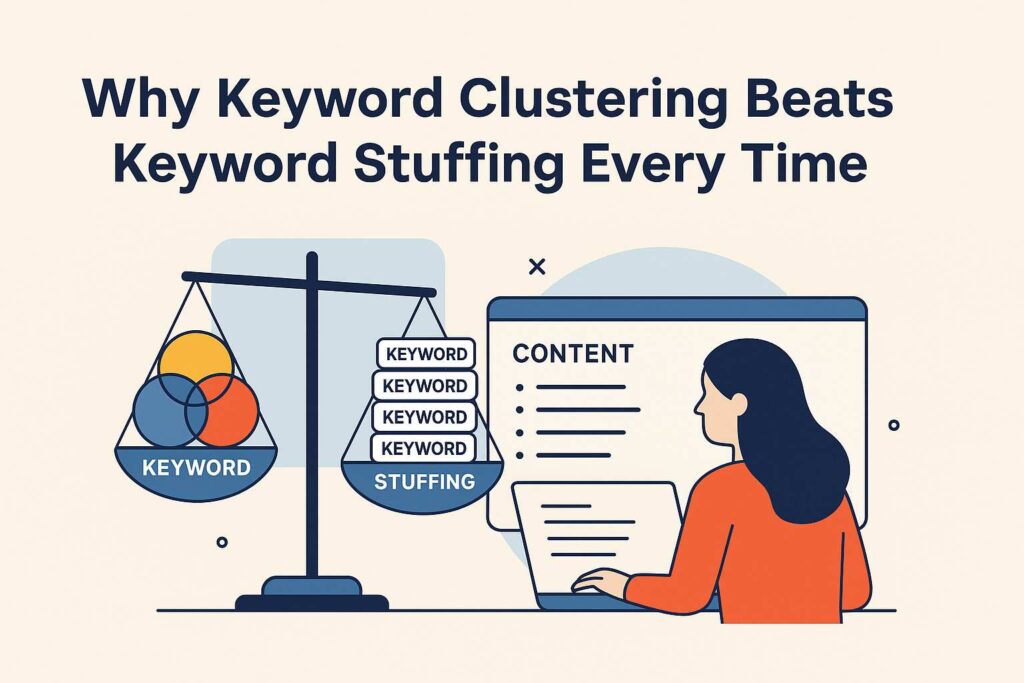Uncovering the Niche Real Estate Keywords First-Time Buyers Actually Use (And How...
Read MoreWhy Keyword Clustering Beats Keyword Stuffing Every Time

Keyword stuffing is out. Clustering is in. If you’re still trying to game Google by repeating the same keywords endlessly, not only are you risking penalties, but you’re missing the real opportunity: ranking across multiple, related searches with smarter, focused content.
This article breaks down why keyword clustering is the future of content creation—and how content writers can use it to rank faster, with less guesswork.
What Is Keyword Stuffing (and Why It Fails)?
Keyword stuffing is the outdated tactic of overloading a page with one target keyword in an effort to rank higher for it. For example:
“Looking for Italian pasta recipes? These Italian pasta recipes are the best Italian pasta recipes for anyone who loves Italian pasta recipes…”
Search engines—and readers—have evolved. Google now penalizes this kind of unnatural repetition, favoring content that naturally answers a topic in depth.
What Is Keyword Clustering?
Keyword clustering is grouping together search terms that share the same search intent. Instead of creating one article per keyword, you create a well-structured piece that answers multiple related queries.
Let’s say you want to write about “freelance writing.” A keyword cluster might include:
how to start freelance writing
freelance writing tips
freelance writing jobs for beginners
how much do freelance writers make
These keywords belong together. One article can target all of them—organically.
Discover your perfect keywords—sign up now!
Discover the power of targeted keywords with our free 3-day trial! Sign up now to access focused keyword insights that will elevate your content strategy and drive traffic to your website. Don’t miss out!
Why Clustering Wins Every Time
1. Wider Search Coverage
Clustering helps your content rank for more terms without creating dozens of repetitive pages.
2. Better User Experience
When users land on your article, they find deeper insights—not just a wall of repeated phrases. That keeps them reading and sharing.
3. Search Engine Preference
Google’s algorithms are built to reward topical authority. A cluster approach helps prove your page covers a subject comprehensively.
4. Less Content, More ROI
Instead of writing 10 average blog posts, you can publish one great post that performs better—saving time and resources.
How to Use Keyword Clusters (Even Without an SEO Team)
Tools like Keyword Studio make keyword clustering accessible to everyone. Here’s how to get started:
Enter a core topic or keyword
See suggested keyword clusters and search intent
Choose one group and write content that addresses all related terms
Use the “focus keyword” as your primary angle—others go into H2s and body
Publish and track rankings across multiple keywords, not just one
No spreadsheets. No manual grouping. No guesswork.
Final Thoughts
Keyword stuffing is a relic of early SEO. Keyword clustering is smarter, faster, and designed for modern search engines. If you’re a content writer trying to rank solo, clustering gives you the power to build SEO-friendly content—without needing to become an SEO expert.
Want to try keyword clustering the easy way?
👉 Start using Keyword Studio and see how your content strategy levels up.
Related Articles
The Definitive Guide to Keyword Research for Luxury Real Estate Marketing
The Definitive Guide to Keyword Research for Luxury Real Estate...
Read MoreHow to Use Keyword Studio as Your Ultimate Keyword Research Tool
How to Use Keyword Studio as Your Ultimate Keyword Research...
Read MoreAvoiding Common Mistakes in Keyword Research for Real Estate in the UK
Avoiding Common Mistakes in Keyword Research for Real Estate in...
Read More



